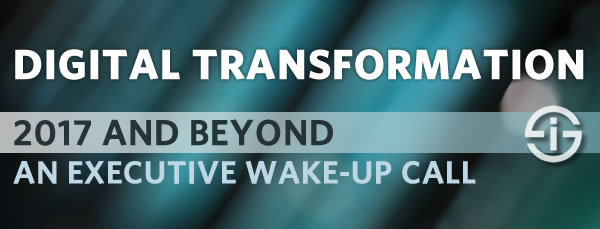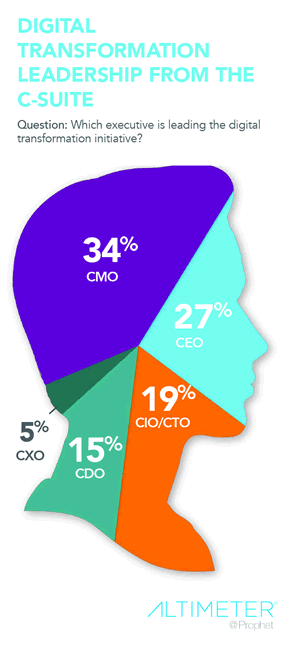IDC VP and Chief Analyst Frank Gens kicked off the 2017 series of IDC FutureScape forecast webinars with, among others a look at the trends in the IT industry. It was also a wake-up call regarding digital transformation.
Whereas end 2015 IDC talked about the nascent digital transformation or DX economy, it became clear that many predictions from last year (the numbers that is) aren’t valid anymore and that in 2017 and beyond things will move even faster.
Why? Because the accelerations in the digital transformation economy and the de facto usage of third platform technologies, enabling transformation, are higher than expected last year. Moreover, technologies and several other evolutions are more impactful (more profound) in many areas than previously thought.

From the arrival of a digital transformation channel (the IT channel reinvented for the age of cloud 2.0 and DX) to predictions regarding changes in management layers and who will lead the enterprise: I’m sure many listeners were baffled as they tried to gain insights to feed their digital transformation strategies.
Business leaders need to step up their efforts and – really – understand digital transformation
Leaving aside an exhaustive overview of the predictions (there are still many FutureScape webcasts coming) and the prediction of a fourth platform, the realities regarding digital transformation are food for a lot of thinking, working and redesigning the enterprise.

What was striking to me were the questions at the end of the webcast. People wanted to know more about digital transformation in business.
They wanted to know more about what blockchain is (and IDC has quite some predictions regarding the evolutions of blockchain or distributed ledger technology too). They wanted artificial intelligence use cases (just look at the need for AI in dealing with unstructured data or how AI and IoT are related).
Wanting to know is great of course but at the same time I wondered.
Looking at these kinds of questions and the predictions of IDC (and the research we see popping up every day regarding the many errors that are made by organizations in digital transformation) it struck me that decision makers in many organizations are still not following technology and market evolutions in the digital space enough.
While we are talking about digital transformation for years now, it is still unclear for many what it means, what are the consequences and how to get started. Admittedly, you get a distorted vision when you are deep into technological evolutions but still: even in the second decade of cloud computing people still have a lot of questions on the so-called third platform pillars, including cloud. The world of technology is one of different speeds and so is the world of digital transformation.
Speak the same language when it boils down to digital transformation – and act
It would be too easy to just blame C-level executives. It would also be too easy to just blame this growing ecosystem of companies and pundits who talk about digital transformation or say they are providing digital transformation solutions, but in fact just use the term digital transformation for their own gain with an ad hoc or siloed view.
Instead of blaming, here are some things we need to stop doing and some we need to start doing (off the top if my head, more coming), as of right now. Why now? Let’s run through some of those IDC predictions first.
What digital transformation already means for your business and what it will mean
Whereas digital transformation has always been about “the profound and accelerating transformation of business activities, processes, competencies and models to fully leverage the changes and opportunities of digital technologies and their impact across society in a strategic and prioritized way”, within a holistic perspective, as we use to call it (and not about digital marketing as I so often see), digital transformation and the nascent DX economy will impact and shape the entire macro economy, IDC’s Frank Gens said in the first FutureScape 2017 webinar.
Why will it reshape the macro economy?
Organizations as digital natives: when DX moves to the core of business
First of all because it will not be about specific projects or business units anymore but because it will move to the core of business and how organizations operate.
Or as Frank Gens put it: all companies will be digital natives. I’m sure that stretches further than many think.
The accelerating acceleration of innovation accelerators
Secondly, because acceleration is accelerating faster. Come again? Allow me to explain.
We talked about the pillars of the third platform before (the SMAC stack, although now it’s often called the SMACIT stack: social, mobile, analytics, cloud and the internet of Things). We also mentioned how, on top of the pillars of the third platform, a range of innovation accelerators were added when IDC talked about the DX economy end of last year.
Well, the growth of these accelerators is moving way faster than the mentioned pillars. Simply said: if you believe that organizations were ‘disrupted‘ by the fast growing adoption of social, mobile, cloud and (big data) analytics, to stick with the original pillars, all those accelerators will affect your business ecosystem even much faster.
As a reminder, these accelerators include AI and cognitive systems, next generation security (with, among others blockchain), AR/VR, the Internet of Things, robotics, 3D printing, you name it.
Business leaders need to understand technologies better
For any business leader it’s crucial to understand these technologies. And that is not new at all. You just need to be more aware and be able to speak with your CIO and understand what these technologies do, mean and will mean.
You don’t have to be able to create a distributed ledger (there will be many blockchains, far beyond the Bitcoin and financial context) but you need to understand what it is, how it impacts your market and what it can do, for instance in combination with the Internet of Things – and at the very least know what it is because it’s coming your way.
You don’t need to know the details of fog computing or be able to set up a LoRaWAN IoT application but you need to understand what the Internet of Things can do and that it’s not about wearables but about real business, whether it concerns the Consumer Internet of Things or the Industrial Internet of Things.
You don’t need to be able to sum up all the artificial intelligence algorithms used to make sense out of your unstructured data but you need to know that there are challenges and opportunities with unstructured data for which you need artificial intelligence.
We can go on but the picture is clear: you need to understand and also act (upon) technology, just as you expect the CIO to understand and act business. Because, again, it’s becoming essential and is moving faster. Business and IT don’t just have to speak the same language, they also need to think and act in an integrated business and technology way.
Digital transformation: shifting from projects to business operations and culture
Moreover, it’s not just the technology aspect that is moving faster. It’s also digital business as such where ecosystems at massive scale will become key assets and digital transformation will need to be shifted from projects, special business units and so forth into the operations and entire culture of the organization.
I’ll leave these ‘predictions’ for now as IDC is about to unleash far more but there is one that might shock you as I’m sure it did many listeners. It isn’t published yet as far as I can tell but let’s say that IDC expects that relatively soon a large portion of CEOs and COOs will have quite some technology leadership experience in major companies. Or in other words: leaders will go.
If you’re looking for data: keep an eye on the IDC press release section where you can already find some predictions in the release at the occasion of the annual FutureScape kick-off (also watch the embedded video below).
Here are a few:
- By 2020, 50 percent of the Global 2000 will see the majority of their business depend on their ability to create digitally-enhanced products, services, and experiences.
- The fastest revenue growth will come from information-based products and services.
- Global digital transformation investment will reach $2.2 trillion in 2019.
Digital transformation: what we need to stop doing
I tackled quite a bit of technology so far. If you know us and this site, you’ll also know we like to look at digital transformation from a holistic business perspective, tackling technology and business (processes, models), also across various verticals and with a clear focus on the human dimension, business goals and, crucial, compliance, security and information management.
Debates about the ownership of digital transformation need to stop
Digital transformation is not owned by the CMO and it’s not owned by the CIO.
Digital transformation, even if it concerns ad hoc projects as it still often does, is by definition an integrated and collaborative effort that belongs to the whole enterprise with the CEO and board being in the lead (IT must be in that board). Contrary to research that shows otherwise, CMOs and CIOs are just partners in digital transformation as we’ve been saying for quite some time.

Research that says that CMOs are in charge of digital transformation, as we’ve seen in September 2016 is not wrong but it is certainly 1) a reflection of the fact that the responding organizations don’t know what digital transformation is and requires and/or could be also 2) the result of a specific focus, panel, way of defining digital transformation in the surveys or survey questions and/or 3) a sole focus on customer experience (although that is often a key goal in transformation projects).
Research that says that CIOs are in charge of digital transformation as we all too often see as well is 1) again a reflection of the misunderstanding and/or wrong focus and/or 2) the fact that, although CIOs (should) have a key role in transformation and the business (as should others), the view is too technology-centric.
Technologies are in the first place enablers of digital transformation, as they are among the causes, but they don’t dominate the business cases.
Again: enterprise-wide digital transformation, which digital transformation in reality always should be, belongs to the enterprise, leadership and an ecosystem of people working beyond organizational and other silos.
Saying that digital transformation is just a new name for an old phenomenon needs to stop
Digital transformation is a profound and ongoing fact, which continues to accelerate at paces which even analysts can’t forecast.
If we keep looking at digital transformation as 1) the digitization of processes and information flows (which it used to mean and which is an important element) as quite some companies in the information management space like to do (because it’s a trendy term and helps them sell their stuff) and/or 2) as just the usage of digital technologies to enhance anything whatsoever, innovate or optimize and/or as 3) just another IT or change project (even if project management, change and IT matter) and/or 4) just a customer experience optimization or a customer-centric ‘digital’ exercise, we miss the essence and look at digital transformation in a far too narrow way.
What else digital transformation is not
Digital transformation is not just about the front end of the business, it is not a synonym for restructuring and it is more than lip service.
If you say you are digitally transforming but your front-end and back-office systems aren’t connected, you don’t cross the bridges of departments, information systems and supply chains, you fail to involve customers, stakeholders and workers, you fail to address challenges of security and legacy, you fail to have a digital ‘culture’ (skillset, understanding, etc. in all areas of the business), you fail to address the needs of today’s increasingly digital and mobile customer, worker etc. in an end-to-end way and, last but not least, you fail to manage change and people in change, but instead keep managing in the good old centralized HiPPO way, you are not digitally transforming.
Digital transformation: what you need to start doing
The just mentioned list of what to stop doing is not exhaustive and neither is this list of what we really need to start doing. But it’s a start.
Start understanding
If everything in business was already connected (processes, people, information, it always de facto was connected, even if leaders and IT leaders missed that simple truth), it sure is hyper-connected today, beyond belief.
As a leader, LOB manager or business person understand the impact of all third platform and other technologies, and, more importantly, how they are interconnected in leading to better and/or entirely new ways to create revenue streams, transform your business model, optimize your process, respond to changing market conditions, anticipate, innovate and far more in a fast and agile way and in a reality that outpaces, well, about anything.
Forge partnerships, create ecosystems
Forge partnerships and create new collaborations, sometimes with organizations and ecosystems that don’t immediately seem to be a fit if you don’t look far enough, in order to be able to focus on digital business transformation and not being outpaced.
This means that you need to work with people and companies or ecosystems that are faster and better than you are in several possible domains. As said, ecosystems become assets and we won’t even tackle the hyper-connected economy of APIs, people, devices, data providers, tech partners, communities, processes, cloud brokers, developers, social touchpoints, innovation ecosystems and whatnot.
Hybrid leaders think, hire, collaborate and learn differently
To conclude, for now, move from traditional linear thinking to an ecosystem view that is far more connected, fluid AND distributed. We called it a sort mesh. Frank Gens called it “an innovation graph” (and showed an image of a social graph/mesh).
Last but not least: hire differently. You will need experts. But you will also need people who truly understand business and technology. Moreover, you will need to become one yourself. In a hybrid world, you need to be a hybrid leader.
Digital transformation is not a journey anymore, it’s a continuous transformation of industries and the economy, at least for the winners of tomorrow.
The others will need to move faster and from practice we know that it takes far more effort and time and gaps to close than the future which is depicted in IDC’s prediction indicate. But you can’t stop the future, you can only prepare for it.
That’s the wake-up call. The rest is learning, doing, failing, learning and doing, in collaboration with (and looking at) those who have done and failed and learned, regardless of industry. Look at use cases and build your networks of expertise and experience for continuous evolution and learning today.
More resources:
- All quotes and data in this article come from IDC’s press release on the first FutureScape 2017 webcast. There is far more. Check it out here.
- There are still several FutureScape 2017 webcasts to come. If you’re really fast you can follow one on digital transformation specifically but there is much more. Check them all out and register.
- IDC knows its content marketing so, on top of the webcasts, keep an eye on the press section and look at the various videos which are on IDC’s YouTube platform and will no doubt be added. Below is one such video in which Frank Gens talks about the scale up of third platform leadership and digital transformation, including some of your hiring needs for ‘DX developers’.
- Finally, register on IDC and get the “IDC FutureScape: Worldwide IT Industry 2017 Predictions” for free.
Disclaimer: we are not affiliated in any way with IDC.
Top image: Shutterstock – Copyright: Cienpies Design – All other images are the property of their respective mentioned owners.

